In the minds of many people, patients with a fungus are often associated with clutter, indifference and dirt. This stereotype is not entirely true. Even the most pedantic cleanliness in the modern world is not immune to fungal infections. In addition, a person who leads an active and healthy lifestyle is more at risk of catching it than the classic couch potato. If the skin between the toes turns red, peels and cracks, the nails turn yellow and fall out, and the unbearable itching does not leave even for a minute, it is most likely a fungus.
Ways of infection
Medical statistics show that every fourth person on the planet suffers from mycosis of the toes. The risk of infection is everywhere: in the pool, sauna, gym, bath, shoe store, on the beach, and even your own shoes often become an excellent environment for the active reproduction and survival of fungi.
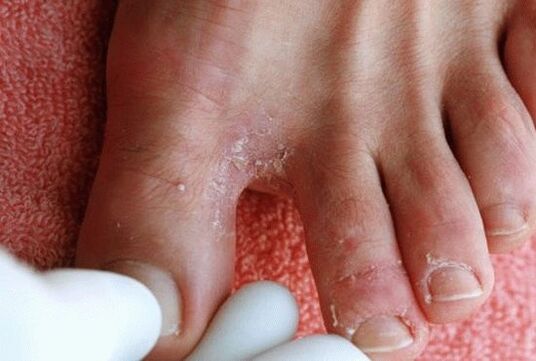
Walking barefoot, wearing someone else's or wet shoes, personal hygiene products (towels, manicure and pedicure tools), dirty socks, excessive sweating, degenerative diseases of the feet, excess weight, circulatory disorders - these and other factors directly or indirectly cause fungus. infection.
Healthy nails are practically invulnerable to fungi, and modified nail plates under the influence of some traumatic factors are easy prey for him. The same thing happens with the skin - microscopic cracks on it become a gateway to infection.
The infection is often caused by fungal parasites called dermatophytes, and less often by yeasts and molds. Male and female toe fungi are equally ill. The risk of infection increases with age. Thus, children are relatively rare victims of this parasite, and every second adult after the age of 70 is its active carrier.
The first manifestations of foot fungus
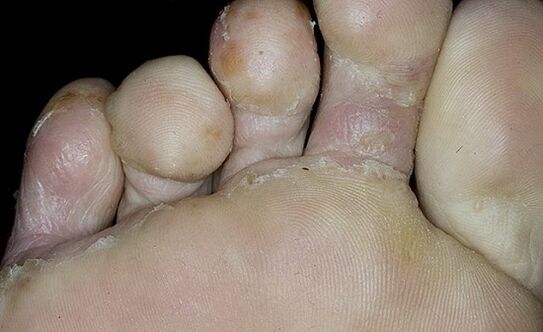
In most cases, fungal infections of the feet occur gradually according to the following scheme:
- the first symptoms are observed in the form of peeling, burning and itching of the skin between the toes;
- the skin reacts to the infection with the formation of bubbles, cracks after a while;
- cracks and grooves appear in place of bubbles; itching intensifies;
- when entering the nails, the fungus actively multiplies, gradually penetrates the nail plate, slowly and for a long time destroys it;
- the plate thickens, erodes, breaks, acquires an unnatural jaundice.
Dermatophyte fungi appear as bright yellow spots or streaks near the edges of the nail. Over time, the infection spreads to the central part, the skin in the interdigital area cracks and severe itching is felt. Yeast fungi feed on the nail plate, thinning the sides. As a result, waves, grooves, cracks appear, the nail turns yellow and separates from the bed. First, the yeast attacks the nail folds. It becomes red, thickens and swells, and silver scales appear along the edges. It is possible to add a secondary bacterial infection with subsequent washing. The molds affect the surface of the nails, changing their shades from yellow and green to brown and even black. These fungi are especially active in the conditions of malnutrition of the nail plates.
Why are you not afraid to consult a doctor?
Treatment should be started as early as possible. This is usually best if the infection, which is initially localized between the toes, has spread to the nail plate. Seeking early medical care ensures faster and healthier nails.
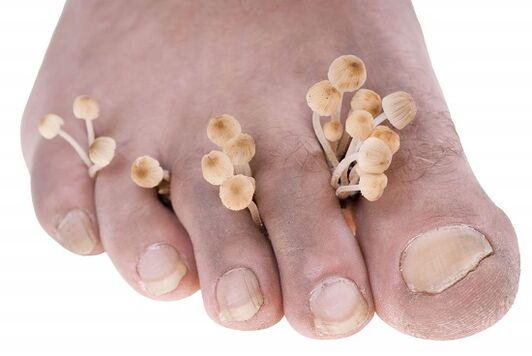
Mycologist is engaged in the treatment of various fungal skin lesions (mycoses). It is difficult to find doctors of this profile in public clinics. If not, you can consult a dermatologist. The task of a specialist is to assess the extent and depth of the lesion, scrape the tissue to determine the presence and type of fungus, and to draw up a competent treatment regimen.
Before starting treatment, it is necessary to carry out disinfection measures, including the treatment of all shoes with vinegar or formalin solution. The bad smell of these products disturbs their use. To solve the problem, you can buy a special device at the pharmacy that disinfects shoes using ultraviolet rays.
Traditional treatment of finger fungus
Foot fungus can be treated locally, systemically or in combination.
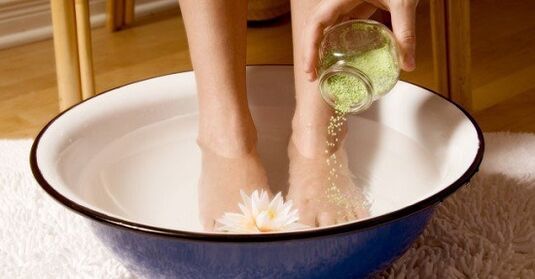
Any treatment includes the use of antifungals (antifungal agents):
- Topical treatment (ointments, creams, sprays). Antifungals for external use and the active ingredient is clotrimazole, naftifine hydrochloride, ketoconazole, terbinafine hydrochloride or bifonazole. In case of minor damage to the nail plate, it is recommended to use antifungal varnishes. Varnishes are applied throughout the year, gradually reducing the frequency of use (4 to 1 time per week). Topical remedies effectively eliminate itching and burning, reduce tingling, cracks in the skin between the toes, but can not completely cure the disease.
- Systemic therapy: common antifungals. This treatment is suitable in case of complete damage to the nail plate. However, there are certain contraindications to systemic antifungal drugs: they should not be taken by pregnant and lactating women, people suffering from kidney and liver disease, and young children.
- Comprehensive treatment. Includes local and systemic therapy.
Patients often complain about the ineffectiveness of traditional treatments and resort to folk remedies. Against the background of such complaints, it was concluded that foot fungus is an incurable disease, and only its symptomatic manifestations (itching, peeling, cracking) can be temporarily eliminated. Why is the patient's dissatisfaction observed? Everything is very simple. In fact, it is difficult to completely cure a fungus, but it is possible. The key is to follow the principles of regularity and timeliness. It is very important to do all the therapeutic activities every day and not interrupt the work you started halfway. You need to be prepared for long-term treatment (usually 3-12 months), which means taking it until new healthy nails grow back. In advanced cases, it is necessary to remove the affected nail plates and only then wait for the appearance of new ones.
Treatment of finger fungus with folk remedies
Traditional medicine recipes are very effective in eliminating or reducing the severity of fungal manifestations such as itching, burning, cracking, peeling and redness of the skin between the toes. Some patients claim that only folk remedies can completely cure the disease.
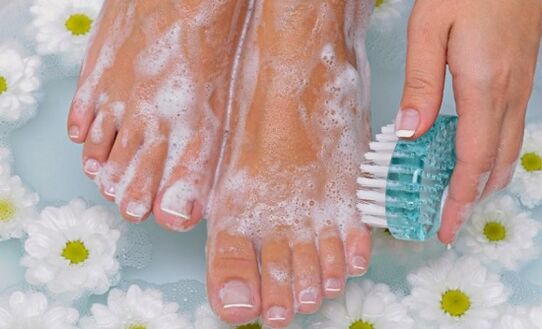
So, to combat the fungus:
- Soak your feet in apple cider vinegar, wine vinegar or table vinegar.
- apply 1 drop of iodine to each nail twice a day;
- wipe your skin and nails with salicylic ointment;
- wash your feet with laundry soap;
- prepare garlic and butter compresses;
- lubricate the affected skin with a mixture of garlic juice, alcohol (1 tablespoon each) and water (2 tablespoons);
- Treat the affected areas with propolis alcohol tincture.
According to reviews, garlic and propolis are especially effective in combating fungi. It is important to understand that the duration of treatment with folk remedies has its limits. If the skin cracks within 3 months and does not look the same, it makes sense to seek help from traditional medicine.
Despite the good effectiveness of folk remedies and the success of modern medicine in the invention of new drugs, foot mycosis remains the most common fungal disease today. Nevertheless, it is gratifying that the number of patients successfully treated in the last 20-30 years is declining every year.

























